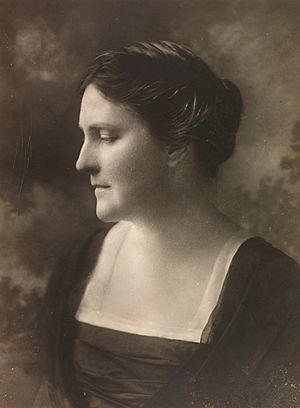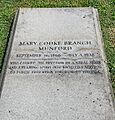Mary-Cooke Branch Munford facts for kids
Mary-Cooke Branch Munford (born September 15, 1865 – died July 3, 1938) was an important activist from Virginia. She worked hard for women's rights, civil rights, the right for women to vote (called women's suffrage), and better education for everyone.
Contents
Early Life and Family
Mary-Cooke Branch was born in Richmond, Virginia. She was the youngest daughter of James Read Branch and Martha Louise Patteson Branch. Her family came from England and was well-known in the area. Her grandfather, Thomas Branch, was a politician. Her nephews included the writer James Branch Cabell and the preacher Walter Russell Bowie.
When Mary-Cooke was three years old, her father died in an accident. He was on his way to a political meeting. Even though her family was wealthy, Mary-Cooke became very interested in helping people and solving social problems from a young age. This interest grew even stronger after she married Beverley Bland Munford in 1893. He was a lawyer who also cared about social issues. They had two children together: Mary Safford, born in 1895, and Beverley Bland, born in 1899.
In the 1890s, Mary-Cooke started a "Saturday Afternoon Club." Women from wealthy families in Richmond met weekly. But Mary-Cooke noticed they preferred talking about polite topics instead of real community problems. So, she became less involved in the club.
Working for Better Education
Improving education was very important to Mary-Cooke Munford. She spent a lot of her life working on this. She held leadership roles in the Cooperative Education Association of Virginia, which started in 1903. She was also one of five women who helped create the Richmond Education Association in 1901.
She strongly supported public schools, which at that time did not get much attention or money in Virginia. The Richmond group was part of a larger national organization. It mainly focused on schools in the countryside. At their yearly meetings, members often visited schools for African-American students in the Southern United States, like the Hampton Institute.
Mary-Cooke had studied in Richmond and New York. But she was sad that she couldn't go to college, even though she really wanted to. Because of this, she worked to make it easier for women to attend college. She tried to create a special college for white women at the University of Virginia. This college would have been connected to the main university.
A law was proposed in the Virginia General Assembly to make this happen. But many people, especially former students of the University, strongly opposed it. The law failed by just two votes in 1916. Even so, Mary-Cooke became a member of the University's Board of Visitors in 1926. She was the third woman to ever serve in this role. After she died, a building on campus was named after her.
She had more success in convincing the College of William and Mary to allow women to attend in 1918. In March 1920, she became the first woman to serve on that school's Board of Visitors. In the same year, she joined the Richmond School Board. This made her the first woman on that board too. Mary-Cooke also worked to improve training for teachers in Virginia. In 1931, she convinced Richmond's school board to change a rule. This rule had stopped married women from working as teachers in the city.
Fighting for Rights
Mary-Cooke Munford was part of many different clubs and groups during her life. These included the Equal Suffrage League of Virginia, which worked for women's right to vote. She was also involved with the Young Women's Christian Association and the National Child Labor Committee. This group worked to stop children from working in dangerous jobs.
After women gained the right to vote with the Nineteenth Amendment to the United States Constitution, Mary-Cooke joined the board of the Virginia League of Women Voters. She also served on the local branch in Richmond. In 1920, she was appointed to the Democratic National Committee, a major political group. She helped start the Virginia Inter-Urban League and was a trustee for Fisk University and the National Urban League. During World War I, she also helped with national defense efforts.
After her husband died in 1910, Mary-Cooke focused more on the rights of African-Americans. She believed in cooperation between different races. She worked to help black communities, though her views were common for wealthy white people of her time. Her father's death, which happened during a rally supporting the right of black people to vote, also shaped her beliefs. She felt he had died for an important cause.
With Janie Porter Barrett, she helped create the Virginia Industrial School for Colored Girls in 1915. She served on its Board of Trustees. While she didn't directly speak about segregation, she worked to help underfunded black communities and neighborhoods in Richmond.
Legacy
Mary-Cooke Munford died in Richmond and was buried at Hollywood Cemetery. Her gravestone honors her work as an education reformer.
Mary Munford Elementary School in Richmond, Virginia, is named after her. A historical marker in front of the school tells about her contributions to education in Virginia. Munford Hall at the University of Virginia was the first dorm for women at the school. Today, it is part of the International Residential College. A former dorm at William and Mary also carries her name. Her personal papers and writings are kept at the Library of Virginia.
Images for kids
-
Munford's gravestone in Hollywood Cemetery, Richmond, Virginia, U.S.



